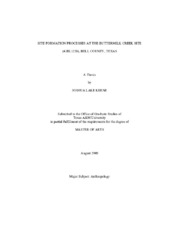| dc.description.abstract | The archaeological literature warns against trusting the context of artifacts found within
a vertisol due to the constant mixing of sediments caused by the shrink/swell properties
of clays. These churning processes were thought to be the defining characteristic of
vertisols until only the past few decades. It is now apparent that vertisols vary
drastically based on a wide spectrum of variables and are fully capable of forming
without churning processes.
The Buttermilk Creek Site, Block A represents a prime example of a minimally
developed vertisol. In addition, the site itself is a heavily occupied lithic quarry that has
been almost continuously inhabited since Clovis and possibly Pre-Clovis times. This
thesis takes a detailed look at the sediments and distribution of lithic artifacts from Block
A of the Buttermilk Creek site to address the two following research objectives: 1) to
determine if the archaeological context within the floodplain sediments at Block A has
been disturbed by post-depositional processes, and 2) to identify discrete occupation
surfaces within the vertic floodplain sediments at the site. These objectives are
addressed using a variety of methods, including: 1) plotting the stratigraphic position of diagnostic artifacts, 2) determining the size distribution of debitage and artifact
quantities throughout the floodplain deposits, 3) examining the distribution of cultural
versus non-cultural lithic material, 4) recording the presence or absence of heat alteration
in the deposits, 5) creating maps showing the degree of fissuring across the site, 6)
analyzing differences in patination on artifacts, and 7) analyzing the presence of calcium
carbonate on artifacts from all levels.
Results from these analyses show that, despite the classification of sediments at
Block A as a vertisol, vertical displacement of artifacts is largely absent.
Chronologically ordered diagnostic points, consistently size sorted artifacts, and a lack
of constant mixing of calcium carbonate throughout the profile suggest that artifacts
found as deep as 20 cm below the Clovis-aged horizon represent intact cultural horizons.
These oldest components found in Block A may represent some of the earliest known
evidence of people in the New World. | en |


